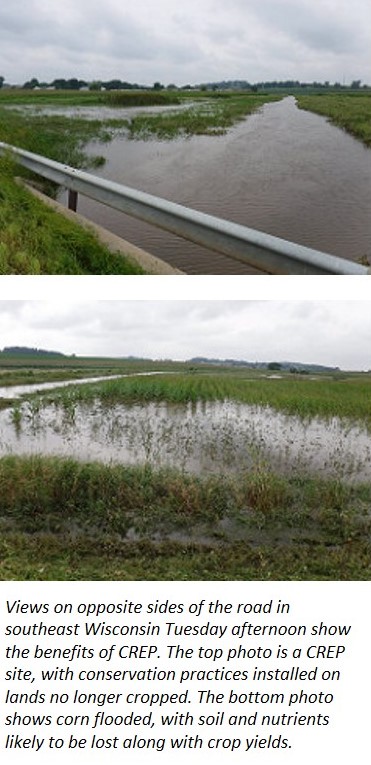Release Date: August 24, 2018
Contact: Donna Gilson, 608-224-5130
Bill Cosh, Communications Director, 608-224-5020
Download PDF
Editors note: You can find high-resolution formats of these photos on our Flickr site: Flooded cornfield and CREP wetland
 MADISON – Farmers whose corn or soybeans are standing in water after this week’s heavy rains in southern Wisconsin might think about enrolling those lands in CREP, says Brian Loeffelholz, who coordinates the program for the Wisconsin Department of Agriculture, Trade and Consumer Protection.
MADISON – Farmers whose corn or soybeans are standing in water after this week’s heavy rains in southern Wisconsin might think about enrolling those lands in CREP, says Brian Loeffelholz, who coordinates the program for the Wisconsin Department of Agriculture, Trade and Consumer Protection.
“When we visited some CREP sites in the flooded parts of the state the next day, the value of the program was very clear,” he said. “On one side of the road, corn would be submerged in water, nutrients were likely running off, and reduced yields or complete crop loss looked inevitable. On the other side, CREP lands were doing their job, absorbing and retaining water and keeping the soil and nutrients where they belonged.”
CREP is the Conservation Reserve Enhancement Program. It’s one component of the federal Conservation Reserve Program, or CRP. The CREP program offers both state and federal financial incentives to landowners who install conservation practices along waterways, or return continually flooded fields or pastures to wetlands. Adjacent land can remain in agricultural production. There is no minimum acreage, and landowners may enroll land under either a 15-year agreement or a perpetual easement.
Lands in 50 Wisconsin counties are eligible for CREP. To be eligible, the land must have been in production at least four years between 2008 and 2013. CREP offers at least 3 types of payments:
Annual payments, typically ranging from $94 to $300 an acre with an average of about $200 statewide, and for pasture land, $45 to $80, with an average of $60
One-time incentive payments, based on the annual rental rate of the enrolled land, and averaging $250 an acre statewide for 15-year contracts and $2,000 an acre for perpetual easements
Practice payments that will cover at least 70 percent of the cost of installing conservation practices
The program is open to landowners enrolling for the first time, or to landowners interested in re-enrolling a 15-year contract that is expiring. To re-enroll or enroll lands for the first time, they should call or visit their local USDA Farm Service Agency office.
"If you're looking at fields that are under water right now, you might want to think about enrolling those lands in CREP," Loeffelholz said. "If you're losing crops or replanting frequently, CREP could help you recoup some of those losses this year. In the future, you wouldn’t have crop losses – instead, you would have a guaranteed income from that acreage."
Available practices include filter strips that place grasslands between crops and water, riparian buffers planted to trees and shrubs between crops and water, and wetland restorations on sites smaller than 40 acres. All these practices reduce flooding impacts by stopping water and allowing it to seep into the soil and subsoil and filtering it before it enters streams.
For more information, visit datcp.wi.gov.
###
Find more DATCP news in our Newsroom, and on Facebook and Twitter.